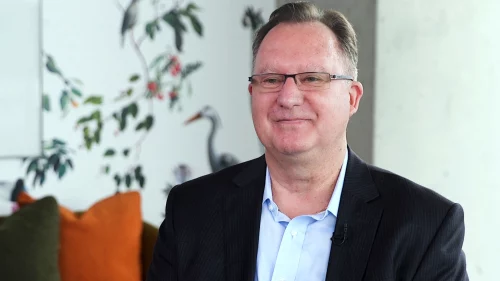Companies and workers face disruption in traditional paths to learning, training, and reskilling. For executives and employees alike, the ability to engage in lifelong learning is fast becoming a critical component of preparedness in the digital age, according to research by the BCG Henderson Institute (BHI).
Phillip Campbell, cognitive scientist and CEO of enigmaFIT, works with major companies to enhance the adaptability and agility of senior executives. He achieves this through a program of repetitive exercises that are based on recent findings on neuroplasticity in adults and boost “fluid intelligence.” The increased effectiveness and efficiency of executives in a disruptive age isn’t the only benefit of this training, Campbell says. Executives also learn to become role models of “adaptive learning” for employees across the entire organization.
Recently, Campbell sat down with Andrew Dyer, a senior partner and managing director in the Sydney office of Boston Consulting Group and a leader of BCG’s client enablement initiative, to discuss these issues and BHI’s own findings. Edited excerpts of that conversation follow.
Phillip Campbell
Phillip Campbell
Born in Australia
Education
BS, University of Melbourne, Australia
Master of Cognitive Science, University of New South Wales, Australia
Career Highlights
2015–present: Founder and CEO, enigmaFIT, New York
2014–present: Board of Governors, The American Chamber of Commerce in Australia; member of the Diversity and Inclusion Committee
1992–2015: Managing director, WorkForce Transformations
2002–2006: Business development director, George Patterson Digital (a division of WPP)
Phillip, thanks for joining us today.
Yes, it’s great to be here, Andrew.
You and I have been talking over the last 12 or 18 months about some of the challenges global business leaders face. I think we all agree that there is an enormous period of disruption ahead of us. I think we all agree that leaders can’t buy in the talent they need, but they need to develop it.
It’s interesting you’re talking about that, because most of the leaders are saying to me, Phillip, I'm being told I need to be more adaptable and agile. And then they have a little look over their shoulder and say, “If I already knew how to do that, I’d be doing that, wouldn’t I, Phillip?”
The emphasis to be able to be more adaptable and agile has gone up about tenfold from there. Cognitive science looks at the way the brain processes information. And neuroplasticity is just the inherent plasticity of the brain to rewire itself to change thinking and behaviors from there.
Imagine I’m a senior executive in a global business that is in the process of deliberately disrupting itself to get ahead of the curve. As the CEO, I’m really concerned that about half of my executive team are getting it.
Yes.
And about half aren’t.
Yes.
And I’ve gone to my head of HR. I’ve gone to my chief learning officer and I’ve asked them to build some programs. And I’m a year in, and I’m frustrated.
Yes.
What would you be saying?
I think we’d begun to understand the way the brain works and learns things. So the traditional focus of most training and education and coaching is knowledge transfer. And this is what’s called, as part of CHC [Cattell-Horn-Carroll] theory, crystallized intelligence. So it’s what you know and everything you’ve learned there.
Now, just because you get greater knowledge and comprehend something doesn’t mean that you can then apply that and change your behavior. What drives that is the corollary of the crystallized intelligence, and it’s called fluid intelligence. And it’s defined as the ability to adapt and solve new and novel problems, particularly in uncharted waters. So you can see in the future we’re going to need the balance between development of fluid intelligence, which is the area that we focus on, and the development of crystallized intelligence.
Many senior business leaders have worked very hard to get to where they’ve got to. They’ve accumulated more knowledge, and information has been a form of advantage for them. It’s terrific that you’ve got this fixed mindset, but what about this capacity to deal with this uncertainty, this volatility to, in fact, make better decisions under uncertainty and how you need to go back and learn some new things? Surely, the responses can be quite strong and quite confronting.
Yes, it is. Particularly if you haven’t got a path forward, which is where a lot of executives find themselves at the moment. If you’re investing all of this time, effort, money, and energy in new digital technology, it’s probably time to invest an equal amount in upgrading the people technology: the brain. We call it the brain operating system. Because my contention is that unless you upgrade the brain operating system to handle all of this additional information and change, then there’s a high risk that the people and the company’s going to get caught like the deer in the headlights.
So it’s back to school for some senior executives? Or is it back to development programs, as opposed to the classroom?
If they went back to school, that would be improving the crystallized intelligence. So they’d learn a lot about what to do, but they wouldn’t know how to do it. So what we’re recommending for the senior executives is to act as role models and then do a test-and-learn approach, and then cascade through the rest of the organization. They really need to switch because what we need to do is to develop the fluid intelligence and it takes about 8 to 12 weeks to grow a new neural pathway or a new brain routine from there. So it’s definitely a development program. It’s not a knowledge transfer program.
What modern enterprises need is a chief capability officer who is able to work out what tasks go to the machine, what tasks stay with the humans, what’s the rate of learning, and what is the learning that’s done by the machines and what is the learning done by the humans. And you’re quite right, there needs to be some ways of connecting the two of them.
I think we all acknowledge huge periods of change upon us and a lot more to come. Leaders need higher levels of decision-making capability, higher and better-performing mental operating systems. And then, indeed, if they don’t do this, they jeopardize the enterprises they work for. Their own personal life in going through these changes is more miserable. And so leadership development needs to fundamentally change…
Change. And I think that’s going to take courage on the part of the CEO to set that up as a strategic direction. To say: Yes, we need a different learning approach and we’ll do a test-and-learn to do that. But it’s also going to need courage from the CFO because they’ve got to fund that. And I think to your point before, I think there’s a new…
…a new social contract emerging between enterprises and their employees.
Yes.
And that the basis of competition we think is moving at the speed of learning, essentially. I share your view that the time has come for a change in the social contract. We’ve seen McDonald’s, Disney, Walmart, AT&T—some of America’s largest enterprises—launch very, very significant tuition reimbursement programs that are basically untied where, you know, in the case of Disney, the 80,000 cast members at their resorts can attend university fully paid for by Disney without an obligation to stay past receiving their degree or accreditation. We’ve seen AT&T spend over a billion dollars on its employee development programs.
Right.
But it strikes me that if the intelligence quotient or the IP of the enterprise is to rise as well, what matters is equipping individuals with the capacity to “learn to learn” and to change their level of cognition. But I wonder if we’ll see those programs expand to include giving someone that new operating system, which in fact probably future-proofs them more than a traditional degree.
And the other thing is that what we are noticing is that some organizations are saying, we can’t quite seem to get the universities giving the snapshot of skill sets, or the mix of skill sets, that we need. And they’re starting to pull together their own ones because it’s quicker and easier for them as well. So that could have an impact of disrupting the universities as well.
Enterprises have operating rhythms; there’s a daily huddle or there’s a weekly touch point or the corporate business review takes place on a quarterly basis. You know, to what extent do you think that these rhythms can be leveraged to create the time for people to learn how to learn, to change the level of aggregate cognition inside an enterprise, and to use those rhythms and routines to help people themselves become better equipped?
Well, what we do as part of doing the program, we literally sit down with the executives or the group and we build that rhythm in. So we say we’ll do it on a regular day, at a regular time, and these are the times to do the practice.
Terrific. Well, thank you very much. It’s been a pleasure.
Okay. Thanks, Andrew.






